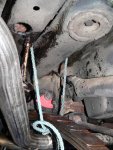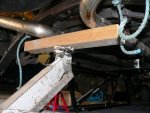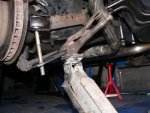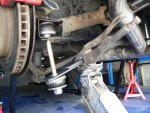antijam
CCCUK Member
To correct a list to port in my '71 I recently replaced the rear spring bolts and rubbers. The bolts were longer than original and not split pinned so allowed differential adjustment side to side. However this adjustment made me realise the core problem was really a tired spring.
So time for a replacement. Hindsight suggests a rear spring swap is easier tackled with the assistance of a helper, the car on a full lift and with the rear exhaust removed but Covid barred any assistance, I don't have a lift and I didn't fancy removing the recently fitted exhaust, so with the car raised sufficiently on my QuickJack to allow me to crawl underneath, I tackled it on my back.
My recently fitted new spring bolts and rubbers were easily removed so time to tackle the four bolts securing the spring to the diff housing. These are beefy 1/2" NC and have been exposed to the elements for 50 years, so I don't expect them to yield easily. My initial efforts with a long ring spanner producing no result, I deem it sensible to attack them with an impact wrench. This seems particularly prudent with the rear two as these are threaded into extended lugs on the rear diff cover and these could well crack under heavy loads applied from a breaker bar and/or hammer. The pure torque from the impact wrench is safer. Even so, it takes several repeated applications of Plus Gas and the wrench to break these free.
To prevent the (heavy) spring landing with a resounding crash onto my exhaust I strap the spring to the diff mount crossmember with a couple of lengths of rope while I remove the bolts and anchor plate.....

.....then support the tailpipes with a jack under a timber bridge and lower the spring gently to rest on them....

......when I can then winkle it out sideways.
I want to clean up the threads in the diff cover but don't have the right tap so I grind a groove in one of the old bolts and use it to chase them out.....

The spring supplied by CK as a replacement for the original has the same nine leaves but these are now interleaved with rubber rather than plastic, which makes the stack thicker so longer bolts are needed. The originals are 3¼" long and the replacements 4"....

New above, old below.
The extra thickness makes it difficult to manoeuvre the new spring past the exhaust and into position but I finally get it resting on the still supported exhaust ready to bolt up. The long new bolts are fine in the two rears as the holes are tapped through the cover bosses but the front two are blind tapped and to ensure the bolts don't bottom before torqueing up I shorten them to 3 11/16". This gives plenty of engagement but ensures they won't bottom, so after hauling the spring into position with my two ropes I insert the bolts through a new anchor plate and tighten them up.
Now just need to refit the spring bolts and rubbers, so clamp a vice-grip to the spring (to prevent a jack slipping ) and jack it up enough....

.....to fit the lower rubber, washer and nut.....

With everything back in place I lower the car to the ground before torqueing the four spring clamp bolts to 60 lbf. ft. After a few miles driving I'll re-torque these as the spring will probably settle a bit.
So now, what's next on my list.......?
So time for a replacement. Hindsight suggests a rear spring swap is easier tackled with the assistance of a helper, the car on a full lift and with the rear exhaust removed but Covid barred any assistance, I don't have a lift and I didn't fancy removing the recently fitted exhaust, so with the car raised sufficiently on my QuickJack to allow me to crawl underneath, I tackled it on my back.
My recently fitted new spring bolts and rubbers were easily removed so time to tackle the four bolts securing the spring to the diff housing. These are beefy 1/2" NC and have been exposed to the elements for 50 years, so I don't expect them to yield easily. My initial efforts with a long ring spanner producing no result, I deem it sensible to attack them with an impact wrench. This seems particularly prudent with the rear two as these are threaded into extended lugs on the rear diff cover and these could well crack under heavy loads applied from a breaker bar and/or hammer. The pure torque from the impact wrench is safer. Even so, it takes several repeated applications of Plus Gas and the wrench to break these free.
To prevent the (heavy) spring landing with a resounding crash onto my exhaust I strap the spring to the diff mount crossmember with a couple of lengths of rope while I remove the bolts and anchor plate.....

.....then support the tailpipes with a jack under a timber bridge and lower the spring gently to rest on them....

......when I can then winkle it out sideways.
I want to clean up the threads in the diff cover but don't have the right tap so I grind a groove in one of the old bolts and use it to chase them out.....

The spring supplied by CK as a replacement for the original has the same nine leaves but these are now interleaved with rubber rather than plastic, which makes the stack thicker so longer bolts are needed. The originals are 3¼" long and the replacements 4"....

New above, old below.
The extra thickness makes it difficult to manoeuvre the new spring past the exhaust and into position but I finally get it resting on the still supported exhaust ready to bolt up. The long new bolts are fine in the two rears as the holes are tapped through the cover bosses but the front two are blind tapped and to ensure the bolts don't bottom before torqueing up I shorten them to 3 11/16". This gives plenty of engagement but ensures they won't bottom, so after hauling the spring into position with my two ropes I insert the bolts through a new anchor plate and tighten them up.
Now just need to refit the spring bolts and rubbers, so clamp a vice-grip to the spring (to prevent a jack slipping ) and jack it up enough....

.....to fit the lower rubber, washer and nut.....

With everything back in place I lower the car to the ground before torqueing the four spring clamp bolts to 60 lbf. ft. After a few miles driving I'll re-torque these as the spring will probably settle a bit.
So now, what's next on my list.......?
